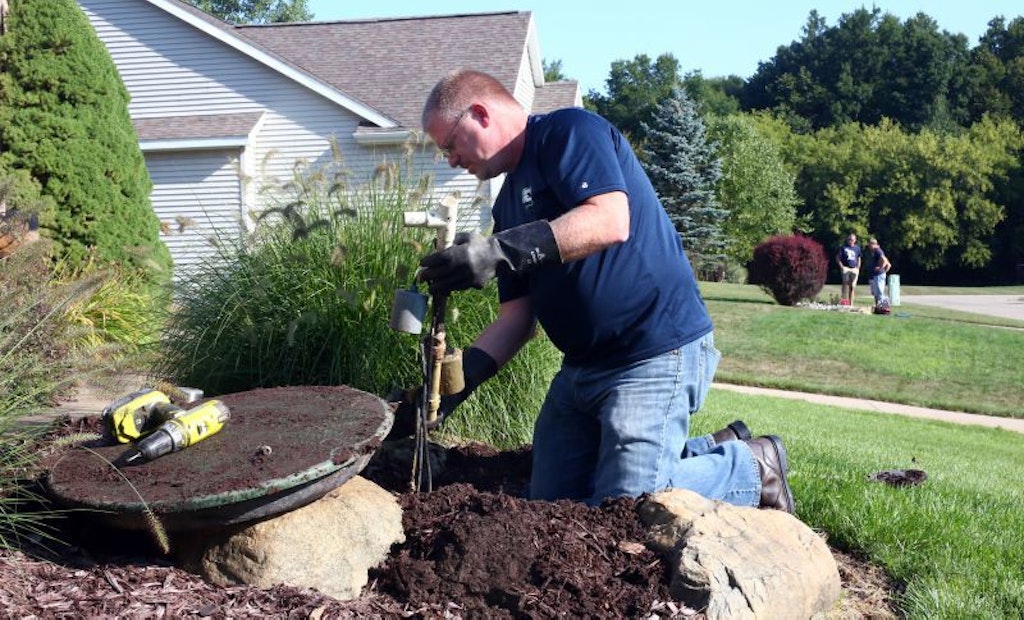Interested in Septic Tanks?
Get Septic Tanks articles, news and videos right in your inbox! Sign up now.
Septic Tanks + Get AlertsAfter pumping the septic tank, in addition to checking the inlet and outlet baffles, the tank should be examined for any cracks or holes where water can infiltrate or leave the tank depending on soil conditions. Sometimes precast concrete tanks have holes in the bottom to allow water to drain out if they are sitting outside at the manufacturing plant. There are two potential problems with holes like this: one is the infiltration which can add unwanted water to the system if the soil around the tank becomes saturated; and the other is that water can leave the tank so the water level in the tank fluctuates. This can allow the scum to move into the outlet baffle, causing plugging; or if there is not an effluent screen, it allows solids to move to the soil treatment area, which causes plugging in the soil.
Tank walls should be evaluated to verify they are watertight. Cracks in the walls can often be identified by excessive staining along the crack. If the tank is a midseam tank, the seam should be closely examined. Methods and materials for sealing midseam tanks have improved dramatically over the years; but if the tank is older, there is a higher probability that there is a problem. Areas at the bottom of the tank where the wall meets the floor should also be evaluated to make sure it is watertight. Again, with newer tanks and better construction, this is not as much of a problem as in older tanks of questionable origin.
Any holes or cracks should be filled. If there are cracks in the tank — this sometimes occurs during tank installation — they should be evaluated for their impact on the structural integrity of the tank and either be repaired or the tank replaced. Most often replacing the tank is the best approach with large cracks or problems at the junction of tank walls and the bottom.
Location of the tank should be evaluated in terms of whether it is in an area where water can run off from another location over the tank. Examples of questions to answer include:
- Is the tank in a drainageway or depression?
- Does the land slope up beyond the tank location?
- Do roof gutters empty over the area?
- Is the tank below the level of the driveway?
Any extra water should be directed or routed away from the tank location. Depending on the situation this can be done by changing where the roof downspouts are located, creating a berm to protect the tank from runoff, or in extreme cases installing a curtain drain.
Any risers or inspection ports should be examined to see that they are properly sealed to prevent water from entering if the surrounding soil becomes saturated. A good indication of a riser not being watertight is if there are roots present. It not only means it is not watertight, but that the problem has been there for a long time. If a manhole riser has been retrofitted to provide ease of locating and access, it is sometimes difficult to get it properly sealed. The fix of course is to replace, reseat or reseal the riser to make it watertight.
About the author Jim Anderson is connected with the University of Minnesota onsite wastewater treatment program and is an emeritus professor in the university’s Department of Soil, Water and Climate. Send him questions about septic system maintenance and operation by sending an email to kim.peterson@colepublishing.com.
This article is part of a series on troubleshooting the drainfield and yard:
- Troubleshooting the Drainfield and Yard
- More Tips for Drainfield Troubleshooting
- Drainfield Troubleshooting: Identifying Invisible Installation Issues
- Drainfield Troubleshooting: Trench Concerns
- Troubleshooting Tips: Tanks and Risers






